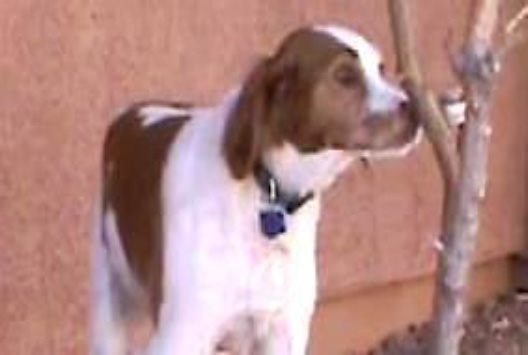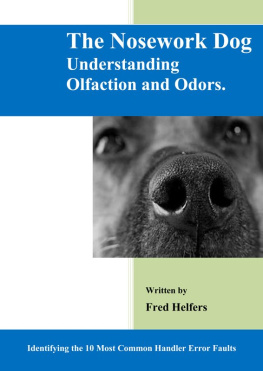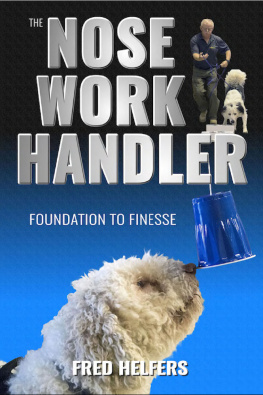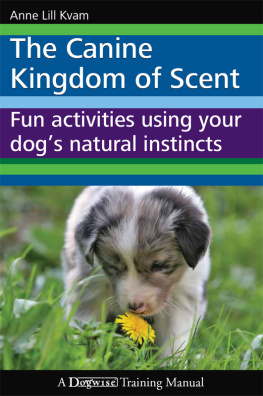Table of Contents
This manual is designed to assist a handler of a detection dog to enhance their teams proficiency in the detection of a trained odor. It is the authors belief that the foundation of a successful handler lays in accumulating both practical experience and a firm knowledge of the Canine Olfactory System.

The manual does not attempt to cover all areas of canine olfaction and odor movement. It is just the foundation, a primer where the handler should continue to learn about odor and olfaction to better understand how their canine partner detects the world of odors.
I must caution those that are new to the field of canine detection. The information contained herein is a foundation. Do not take this information and over analyze each scenting problem, let your dog teach you. Train dont Test.
Watch your dog as they unravel each new scenting problem.
TRUST your dog!


So be patient, learn from your dog and above all else, let your dog have fun!
Fred HelfersMaster Trainer detection canines.
Acknowledgements:
I would like to acknowledge continued help and education from the following persons.
Dr. Ken Furton, Dean of Chemistry, Florida International University. A friend for over 10 years, Ken has shown me that science does in fact have a substantial place in the training of detection canines and challenging me to become a better canine trainer through science.
Dr. Brent Craven, Penn State University, for graciously allowing the use of detailed diagrams of the canines nose.
The Nosework Dog
I have instructed and judged at many detection dog seminars over the past 30 years. What I have noticed was the large amount of detection dog handlers who had little or no knowledge of the dogs nose. Amazing! When you think about it, the most integral part of the dogs ability to smell, the Nose (olfactory system) is often overlooked as an area of learning by the detection dog handler. If a person is truly interested in becoming a handler or trainer of detection dogs then having knowledge of dog olfaction and the science of odor is a must!
Understanding how the dog processes odor molecules and what elements affect odor molecules will enable the detection dog handler to better apply their detection dog and become a more successful part of that team.
William Syrotuck in his much acclaimed book Scent and the Scenting Dog writes, Scent,can be described as being a combination of odors, whereas; the word odor relates to a specific thing or object. When I discuss detection dogs and use the word odor, I am referring directly to that odor that is emanating, or coming from a specific source.
Olfactory ability is the ability of a dog to smell different odor molecules and use scent discrimination in identifying a trained odor. So what is Smell? For you and your dog to smell something molecules from the source have to make it to the nose. Therefore it is no surprise everything you smell gives off molecules.
Odor Molecules Generally speaking, odor molecules that can be smelled are:
Lightweight (move in the air).
Volatile (evaporate easily).
Soluble (broken down by moisture).
The Sniffing Process - As you will learn odor molecules enter the nose and become soluble in mucous. Therefore, two things must be present.
Moisture + Heat
Odor molecules are detected by the dog when a molecule carried in the atmosphere is picked up by the dog and enters the dogs nasal cavity. At such a time the odor molecule travels towards the rear of the nose and gathers moisture from the mucous in the nose. When the odor molecule contacts the olfactory cilia (nerve endings) at the olfactory lobe, the olfactory lobe then sends electronic signals to the brain telling the dog what the odor is.
Canine Olfactory System
Turbinates are bony ridges covered in mucous that control air movement.
 Maxillo-turbinates create turbulence and begin heating and moistening the odor molecules.
Maxillo-turbinates create turbulence and begin heating and moistening the odor molecules.
 Ethmo-turbinates are located further back in the nasal chamber and have the greatest concentration of olfactory receptors. Here the odor molecules spin faster and generate more heat.
Ethmo-turbinates are located further back in the nasal chamber and have the greatest concentration of olfactory receptors. Here the odor molecules spin faster and generate more heat.

Figure 1
Olfactory cells, also known as receptors, are suspended in the mucous layer.
Receptors have protruding filaments that capture odor molecules.
Receptors are sparsely distributed at the front of the nose and become dense further back in the nose.

Figure 2
The olfactory lobe is the area of the brain where odor is recognized, interpreted, and filed for memory.

Figure 3
The vomeronasal organ:
Is a narrow tubular canal running behind the front part of the nose, behind the canine teeth, and along the roof of the mouth.
Have olfactory cells and nerve bundles that connect directly to the olfactory lobe of the brain.
Keeping the canines teeth healthy will prevent infection that could affect the canines olfactory system and ensures the canines ability to detect odors.

Figure 4
Breathing vs. Sniffing:
During breathing, airflow takes a curved course up to the middle of the nose and below the olfactory area.

Figure 5
During sniffing, the canine uses sharp inhalation to pull the odor into the turbinates to help detect a particular odor.

Figure 6
When you compare the olfactory system of man to the canine, it is easily understood why the canine is far superior to the human in terms of olfactory capabilities. The average human being has a very small and simple sense of smell. (Olfactory system).
In comparison the canine has a very acute sense of smell, with olfactory systems that has a large olfactory lobe and elaborate nose design.
Further comparison of olfactory systems shows that humans have approximately 5 million olfactory sensory cells within their olfactory system. A large breed canine may have over 200 million sensory cells within their olfactory system.

















 Maxillo-turbinates create turbulence and begin heating and moistening the odor molecules.
Maxillo-turbinates create turbulence and begin heating and moistening the odor molecules.




